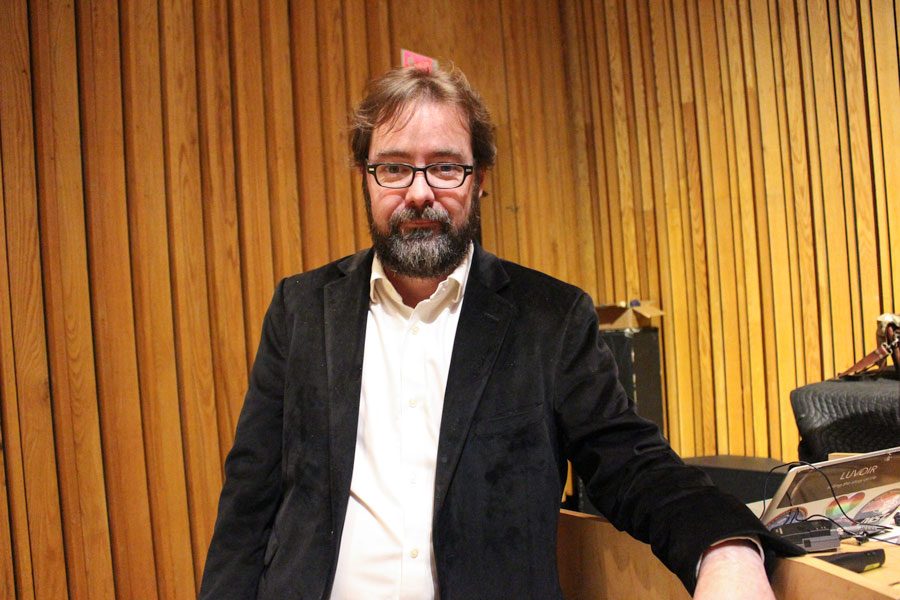Starstruck in Bentley 207
John O’Meara
John O’Meara, physics professor and department chair at St. Michael’s College, is unsurprisingly smarter than I am. In fact, he is so much smarter that when I sat in on his lecture for the Environmental and Health Science Speaker Series, Fingerprints of the First Stars: Unraveling the Atomic History of the Universe, I felt truly lost in space..
The passionate professor is also an observational astronomer, someone who records data about the observable universe. “Observational astronomy requires use of very large, and often times very expensive, facilities,” said O’Meara. “It requires a lot of travel, a lot of computer processing time and this is usually done in collaborations.”
Many of these collaborations are done with the use of NASA and National Science Foundation grants. “The last bit of fun for my career in the last few years is that I’ve actually become fairly involved with NASA in the planning of telescopes which have not yet launched,” he said.
O’Meara then read a quote by Galileo: “All truths are easy to understand once they are discovered; the point is to discover them.” After that, he delved into looking at the imprints of the universe from the first generation of stars to ever exist.
O’Meara said everything he has discovered is through the use of two things: “The combination of a telescope, which allows you to see things very far away, and atomic physics lets you understand just about anything anywhere in the universe,” he said.
He then went on to explain what Neil Degrasse Tyson has been saying for years: we are made of stardust. “That’s where every carbon atom in you came from,” said O’Meara. “It came from a previous generation of stars that lost the initial battle between gravity and pressure, began a new one and started to create, from the helium ashes of fusion, carbon.”
The oxygen we breathe is apparently due to the same process of late-stage star fusion that happened eight billion years ago.
O’Meara, and astronomers like him, are able to test theories about the universe through computer simulations. “The only way we can really test theories cosmologically is to create fake universes inside them,” he said. “Putting as much physics as we can, let the clock start, and hope that by the time you get to T=today, you’ll have a universe that actually looks like ours.”
O’Meara transitioned from his universe history lesson to the work he does today so seamlessly that I hadn’t even realized it happened. Astronomers have to do is come up with names for everything. O’Meara walked us through the naming and classification of different stars. “In astronomer nomenclature we name stars after populations. So a Population I star is a star like the sun,” he said. “It is a third or fourth generation star, it is the byproduct of many generations of stars going through their full life cycles giving that material back to the interstellar medium and then creating new stars. Population II stars, on the other hand, are a slightly previous generation to that. They have a lower heavy element content, less carbon in them, less oxygen in them. They are older stars. We see these in the outskirts of the galaxy.”
Population III stars, the ones O’Meara is after, are the very first stars in the universe and were created 400 billion years after the Big Bang. “They are built entirely out of hydrogen and helium left over from the Big Bang, and they have identically zero carbon, oxygen, nitrogen, anything else in the periodic table.”
Through a series of graphs that looked to me like the results of a lie detector test, O’Meara is able to deduce what elements make up the atmosphere of the Earth’s sun, which includes hydrogen, helium, carbon, nitrogen and oxygen. “I have done something truly amazing,” he said. “I have measured what atoms are in the atmosphere of the sun without ever going there. All I needed to do was know atomic physics.”
The discoveries made by O’Meara and his colleagues were made possible by the Keck Observatory on the dormant volcano Mauna Kea in Hawaii. According to its website, the observatory houses the world’s two most scientifically productive optical and infrared telescopes that operate with nanometer precision.



